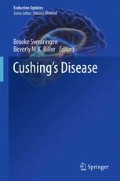Abstract
Adrenocorticotropin (ACTH)-producing pituitary adenomas are derived from corticotroph cells in the anterior pituitary gland. Most of them secrete excess ACTH leading to cortisol overproduction or Cushing’s disease. However, ACTH-producing pituitary tumors are heterogeneous and differ in histologic, immunohistochemical, and ultrastructural findings as well as in clinical presentations and prognosis. In this chapter, the histopathology of ACTH-producing adenomas and their clinicopathologic correlations are described.
Access this chapter
Tax calculation will be finalised at checkout
Purchases are for personal use only
References
Lopes MBS, Pernicone PJ, Scheithauer BW, Horvath E, Kovacs K. Pituitary and sellar region. In: Mills SE, editor. Histology for pathologists. 3rd ed. Philadelphia, PA: Lippincott Williams and Wilkins; 2007. p. 321–44.
Raffin-Sanson ML, de Keyzer Y, Bertagna X. Proopiomelanocortin, a polypeptide precursor with multiple functions: from physiology to pathological conditions. Eur J Endocrinol. 2003;149(2):79–90.
Lloyd RV, Kovacs K, Young Jr WF, et al. Tumours of the pituitary. In: DeLellis RA, Lloyd RV, Heitz PU, Eng C, editors. World health organization classification of tumours. Pathology and genetics of tumours of endocrine organs. Lyon: IARC; 2004. p. 9–39.
Burger PC, Scheithauer BW, Vogel FS. Region of the sella turcica. In: Burger PC, Scheithauer BW, Vogel FS, editors. Surgical pathology of the nervous system and its coverings. 4th ed. Philadelphia, PA: Churchill Livingstone; 2002. p. 437–97.
Asa SL. Pituitary and suprasellar tumours. In: Love S, Louis DN, Ellison DW, editors. Greenfield’s neuropathology. 8th ed. London: Hodder Arnold; 2008. p. 2088–107.
George DH, Scheithauer BW, Kovacs K, et al. Crooke’s cell adenoma of the pituitary: an aggressive variant of corticotroph adenoma. Am J Surg Pathol. 2003;27(10):1330–6.
Banasiak MJ, Malek AR. Nelson syndrome: comprehensive review of pathophysiology, diagnosis, and management. Neurosurg Focus. 2007;23(3):E13.
Assie G, Bahurel H, Bertherat J, Kujas M, Legmann P, Bertagna X. The Nelson’s syndrome… revisited. Pituitary. 2004;7(4):209–15.
Karavitaki N, Ansorge O, Wass JA. Silent corticotroph adenomas. Arq Bras Endocrinol Metabol. 2007;51(8):1314–8.
Stefaneanu L, Kovacs K, Horvath E, Lloyd RV. In situ hybridization study of pro-opiomelanocortin (POMC) gene expression in human pituitary corticotrophs and their adenomas. Virchows Arch A Pathol Anat Histopathol. 1991;419(2):107–13.
Tateno T, Izumiyama H, Doi M, et al. Differential gene expression in ACTH-secreting and non-functioning pituitary tumors. Eur J Endocrinol. 2007;157(6):717–24.
Ohta S, Nishizawa S, Oki Y, Yokoyama T, Namba H. Significance of absent prohormone convertase 1/3 in inducing clinically silent corticotroph pituitary adenoma of subtype I–immunohistochemical study. Pituitary. 2002;5(4):221–3.
Tateno T, Izumiyama H, Doi M, Akashi T, Ohno K, Hirata Y. Defective expression of prohormone convertase 1/3 in silent corticotroph adenoma. Endocr J. 2007;54(5):777–82.
Utz AL, Swearingen B, Biller BM. Pituitary surgery and postoperative management in Cushing’s disease. Endocrinol Metab Clin North Am. 2005;34(2):459–78. xi.
Kelly DF. Transsphenoidal surgery for Cushing’s disease: a review of success rates, remission predictors, management of failed surgery, and Nelson’s Syndrome. Neurosurg Focus. 2007;23(3):E5.
Gejman R, Swearingen B, Hedley-Whyte ET. Role of Ki-67 proliferation index and p53 expression in predicting progression of pituitary adenomas. Hum Pathol. 2008;39(5):758–66.
Saeger W, Ludecke B, Ludecke DK. Clinical tumor growth and comparison with proliferation markers in non-functioning (inactive) pituitary adenomas. Exp Clin Endocrinol Diabetes. 2008;116(2):80–5.
Hsu DW, Hakim F, Biller BM, et al. Significance of proliferating cell nuclear antigen index in predicting pituitary adenoma recurrence. J Neurosurg. 1993;78(5):753–61.
Kaltsas GA, Nomikos P, Kontogeorgos G, Buchfelder M, Grossman AB. Clinical review: diagnosis and management of pituitary carcinomas. J Clin Endocrinol Metab. 2005;90(5):3089–99.
van der Klaauw AA, Kienitz T, Strasburger CJ, Smit JW, Romijn JA. Malignant pituitary corticotroph adenomas: report of two cases and a comprehensive review of the literature. Pituitary. 2009;12(1):57–69.
Thapar K, Kovacs K, Scheithauer BW, et al. Proliferative activity and invasiveness among pituitary adenomas and carcinomas: an analysis using the MIB-1 antibody. Neurosurgery. 1996;38(1):99–107.
Hosaka N, Kitajiri S, Hiraumi H, et al. Ectopic pituitary adenoma with malignant transformation. Am J Surg Pathol. 2002;26(8):1078–82.
Tanizaki Y, Jin L, Scheithauer BW, Kovacs K, Roncaroli F, Lloyd RV. P53 gene mutations in pituitary carcinomas. Endocr Pathol. 2007;18(4):217–22.
Author information
Authors and Affiliations
Corresponding author
Editor information
Editors and Affiliations
Rights and permissions
Copyright information
© 2011 Springer Science+Business Media, LLC
About this chapter
Cite this chapter
Cheunsuchon, P., Hedley-Whyte, E.T. (2011). Pathology of Cushing’s Disease. In: Swearingen, B., Biller, B. (eds) Cushing's Disease. Endocrine Updates, vol 31. Springer, Boston, MA. https://doi.org/10.1007/978-1-4614-0011-0_3
Download citation
DOI: https://doi.org/10.1007/978-1-4614-0011-0_3
Published:
Publisher Name: Springer, Boston, MA
Print ISBN: 978-1-4614-0010-3
Online ISBN: 978-1-4614-0011-0
eBook Packages: MedicineMedicine (R0)

